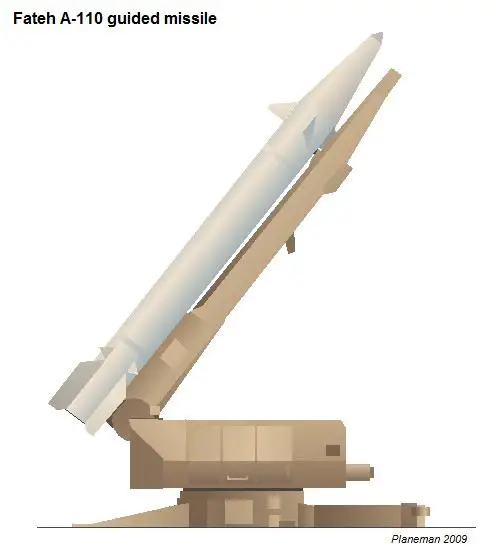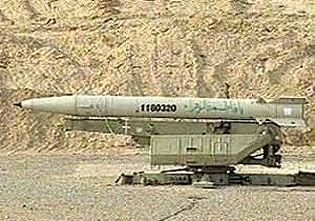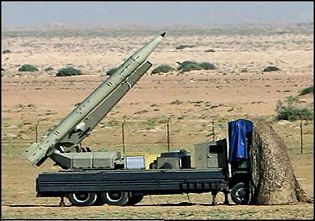- Army
- Air Defense Systems
- Anti-tank systems and vehicles
- Armored Vehicles
- Armoured personnel carriers
- Artillery Vehicles and Weapons
- Command Post
- Communication Vehicles and Systems
- Electronic Warfare
- Engineer | Maintenance Vehicles
- Infantry Fighting Vehicles
- Main Battle Tanks
- Missiles
- Tactical and Logistic Vehicles
- Radars
- Unmanned Systems
- Weapons
- Navy
- Air
Fateh-110 Fatah A-110
|
Fateh-110 Fatah A-110 short-range ground-to-ground ballistic missile
|
|||||||||||||||||||||||||||||||||
|
|
|||||||||||||||||||||||||||||||||
|
a
|
|||||||||||||||||||||||||||||||||
 |
|||||||||||||||||||||||||||||||||
| The Fateh A-110 is a short-range, road-mobile, solid-propellant ballistic missile based on the Russian made missile R-65 FROG, but other sources said it is a copy of the Chinese DF-11. It is most likely a modified version of the unguided Zelzal-2 ground-to-ground missile, with the addition of control and guidance systems.1 The Fateh A-110 is designed to replace many of the aging Scud systems currently used in the Iranian armed forces. Iran began developing the Fateh A-110 in 1997. The first test flight of the Fateh A-110 took place in May 2001, with a second the following September of 2002.3 A third test was recorded in February 2003. A fourth test was successfully completed during the second Holy Prophet military exercise in November 2006. The Iranian Revolutionary Guard successfully tested the Fateh in January of 2007 during an annual war game. A fifth successful test was completed in September 2007 alongside the Qadr-1 and the Shahab-3. Additional test flights have probably taken place. During its tests, the Fateh A-110 was fired from a fixed launcher similar to the one used by the Russian S-75 Guideline surface-to-air missile. However, it is more likely that Iran has designed a launch vehicle to make Fateh A-110 road-mobile. In September 2010, the Iranian Defense Ministry announced that army units are equipped with the third generation of Fateh-100 missile with an upgraded range of 300 km. The Fateh A-110 was designed to replace the old Russian-made ground-to-ground ballistic missile Scud systems currently used in many countries in the Middle East and also in Iran. The Fateh-110 was also exported to Syria. |
|||||||||||||||||||||||||||||||||
| Variants | |||||||||||||||||||||||||||||||||
| - Fateh-110: First variant. With a range of 200 km. - Fateh-110/II or Fateh A-110A: Second Generation Announced in 2004. It has a range between 160 and 210 km, but it is possible that Iran will add an extra booster to increase the range of the missile to 400 km. - Fateh-110/III or Fateh 3 A-110B: Third Generation Announced in 2010. The operational range of 250 km in place of 210 km for Fateh-110. It is expected that the A-110B will have a slightly reduced payload of 480 kg and an accuracy of 250 m CEP. - Khalij Fars: is an Anti-ship ballistic missile based on Fateh-110. Unveiled in 2011. - M-600: Syria has manufactured its own version of the Fateh-110, known as the M-600 |
|||||||||||||||||||||||||||||||||
| Technical Data | |||||||||||||||||||||||||||||||||
| Back to top | |||||||||||||||||||||||||||||||||
|
|||||||||||||||||||||||||||||||||
 |
|||||||||||||||||||||||||||||||||
|
|||||||||||||||||||||||||||||||||
| Back to top | |||||||||||||||||||||||||||||||||
|
{youtube}ywLNflCGkVc{/youtube}
|
|||||||||||||||||||||||||||||||||





























